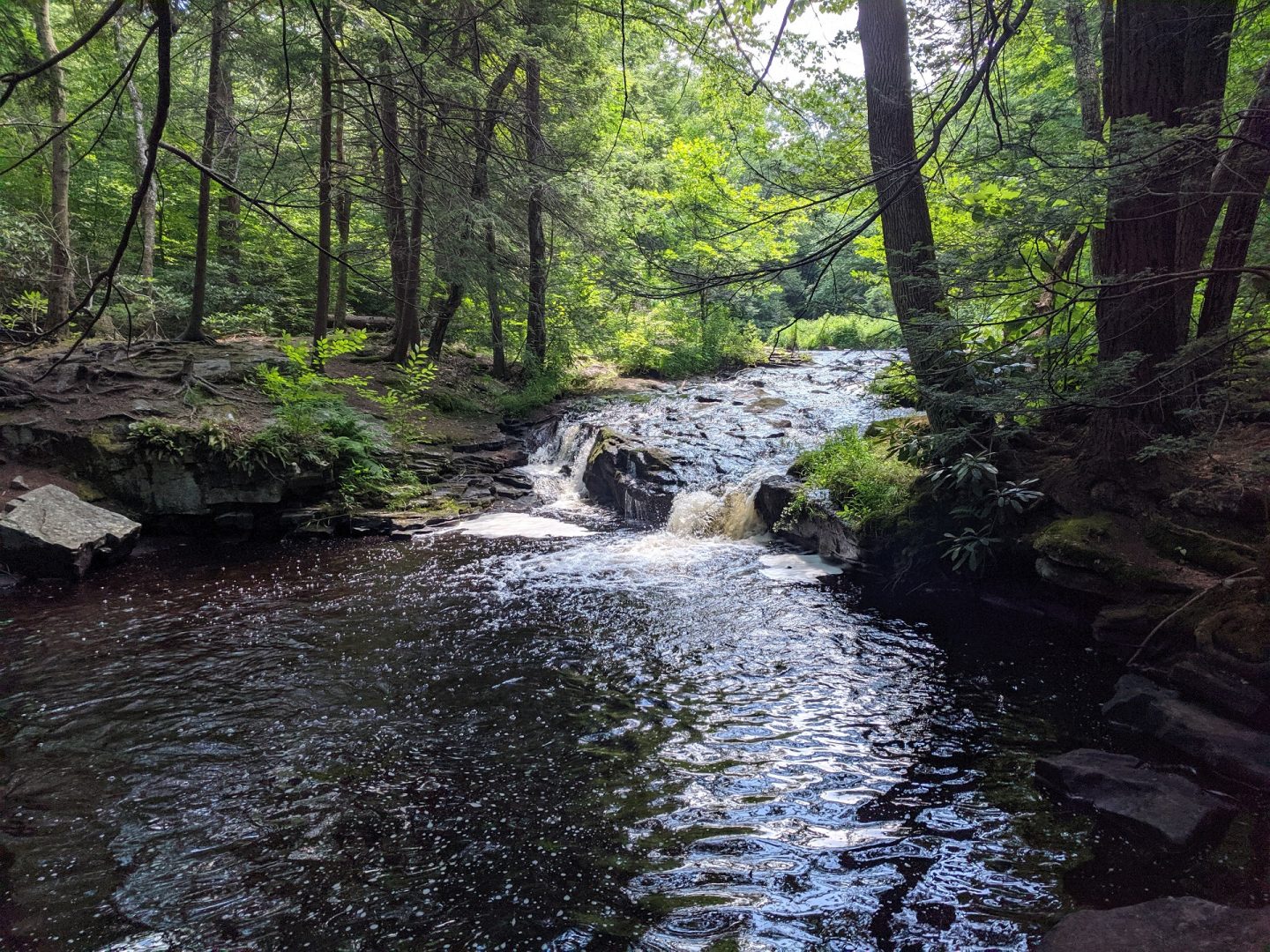
The east branch of Wallenpaupack Creek runs through Promised Land State Park in Pike County.
Rachel McDevitt / StateImpact Pennsylvania


The east branch of Wallenpaupack Creek runs through Promised Land State Park in Pike County.
Rachel McDevitt / StateImpact Pennsylvania

Rachel McDevitt / StateImpact Pennsylvania
The east branch of Wallenpaupack Creek runs through Promised Land State Park in Pike County.
The state Department of Conservation and Natural Resources says climate change is front-and-center as it plans for the future of the Commonwealth’s parks.
That’s according to “Penn’s Parks for All,” a plan DCNR released at the end of July to guide the management of state parks for the next 25 years.
The plan, which covers a range of topics from overnight lodgings to trail upkeep, calls for improvements in the accessibility of campgrounds, trails, and transportation.
It also says it will be crucial in the coming decades to protect habitat — and the wildlife that lives in and migrates through it — from the effects of climate change.
“Climate change is a huge component of this,” said John Hallas, director of the Bureau of State Parks. “It impacts every facet of our operations.”
The plan came a little over a week before a major report from the Intergovernmental Panel on Climate Change that summarizes current scientific knowledge on the climate crisis.
It says climate change is already having severe effects, from more intense heat waves to stronger storms, and that rapid action is crucial to avoid the worst impacts.
DCNR recommends a number of strategies to both mitigate and adapt to the consequences of climate change, including using more renewable energy on park land and restoring parts of parks hit by storms.
“We know that climate- and weather-related incidents are impacting access because they’re degrading trails,” Hallas said. “If we want to provide future access, we have to do something,” like rerouting or rebuilding them.
The plan also warns that alongside the most immediate climate hazards in Pennsylvania — like higher temperatures, heavier rains, and worse flooding — climate change can exacerbate other strains on the landscape.
“It is the primary threat-multiplier to our system,” Hallas said.
For instance, if an animal already faces obstacles like roads and buildings when it’s trying to migrate, removing those barriers becomes even more urgent if it’s one of the many species heading for cooler territory in the face of climate change.
Toni Lyn Morelli, an ecologist at the U.S. Geological Survey’s Northeast Climate Adaptation Science Center, said connected stretches of habitat — uninterrupted by highways or high-rises — are crucial for those animals.
She said certain kinds of habitat where the effects of climate change aren’t quite so pronounced — known as climate change refugia — are particularly important to protect for migrators.
Mountains, she said, are a classic example: the slopes provide shade from the sun, and valleys trap cold air that can serve as a respite from higher temperatures in the surrounding area.
Morelli noted that these sanctuaries are temporary; they aren’t immune to the effects of climate change, either. But they’re likely to change more slowly than other parts of the landscape.
“If we can identify them, we could potentially protect them from other stressors,” Morelli said. “They can be these havens for species, at least in the short-term.”
When it comes to these kinds of habitats in Pennsylvania, one of the best places to look is the Kittatinny Ridge, a segment of the Appalachian Mountains that spans 185 miles from Fulton to Monroe counties. It’s one of Pennsylvania’s eight “conservation landscapes,” areas where DCNR leads environmental restoration and economic development projects.
It’s also a key flyway for migratory birds, classified as a Global Important Bird Area by the National Audubon Society because of the thousands of birds of prey that pass through every year.
“What you have is a large, long, connected natural space,” Hallas said, making the Ridge an obvious target for conservation.
Jeanne Ortiz, who works on conservation of the Kittatinny Ridge with Audubon Mid-Atlantic and DCNR, is helping lead an effort to create “bird-friendly communities” in the region.
In Duncannon this fall, project leaders and volunteers will put in a native plant garden at the Clark’s Ferry Tavern, a site owned by the Historical Society of Perry County. People who live nearby can also take plants home.
“Those native plants will help us provide connectivity across the ridge so that wildlife moving from a preserved parcel can go through a more-developed area and still find sustenance,” Ortiz said.
Morelli agreed mountainous areas like this one are good candidates for these kinds of conservation projects.
“We can’t do it everywhere because we have limited resources, so where should we do it? We should do it in climate corridors and refugia,” she said.
Ortiz said the effort is still in the pilot stage.
“The plan is to increase the number of bird-friendly communities in boroughs across the ridge in the future.” Hopefully, she said, getting more participants onboard will help the project cover a larger geographic area.
Demonstration gardens are also planned for Harrisburg and Lehighton next year.
StateImpact Pennsylvania is a collaboration among WITF, WHYY, and the Allegheny Front. Reporters Reid Frazier, Rachel McDevitt and Susan Phillips cover the commonwealth’s energy economy. Read their reports on this site, and hear them on public radio stations across Pennsylvania.
(listed by story count)
StateImpact Pennsylvania is a collaboration among WITF, WHYY, and the Allegheny Front. Reporters Reid Frazier, Rachel McDevitt and Susan Phillips cover the commonwealth’s energy economy. Read their reports on this site, and hear them on public radio stations across Pennsylvania.
Climate Solutions, a collaboration of news organizations, educational institutions and a theater company, uses engagement, education and storytelling to help central Pennsylvanians toward climate change literacy, resilience and adaptation. Our work will amplify how people are finding solutions to the challenges presented by a warming world.